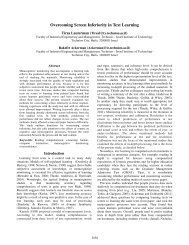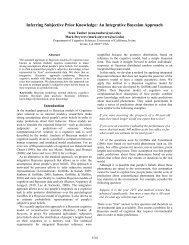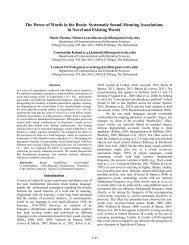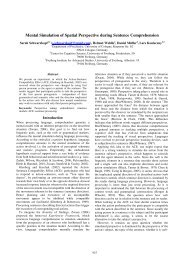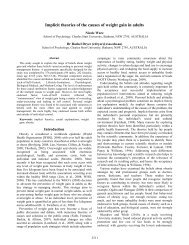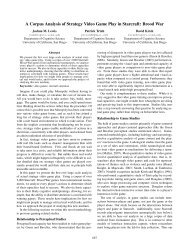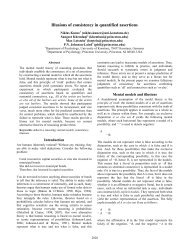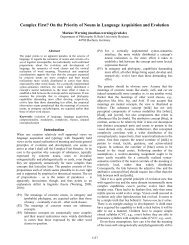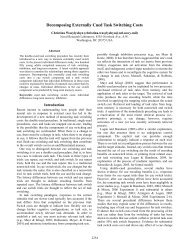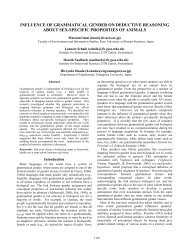Uncertainty and dependency in causal inference - Cognitive ...
Uncertainty and dependency in causal inference - Cognitive ...
Uncertainty and dependency in causal inference - Cognitive ...
Create successful ePaper yourself
Turn your PDF publications into a flip-book with our unique Google optimized e-Paper software.
asymptotically approach 1.0 (see Figure 2). The salience of<br />
cue i depends on whether the cue is present (sj = α) or absent<br />
(si = 0.0), <strong>and</strong> the salience of cue j (which could be the<br />
effect) also depends on whether the cue is present (sj = α) or<br />
absent (sj = k1).<br />
A f<strong>in</strong>al 2 parameter k2 controls the strength of the<br />
competition from the <strong>in</strong>direct activation of the effect.<br />
Follow<strong>in</strong>g Stout <strong>and</strong> Miller (2007), we set α = .7071, k1 =<br />
.1768, k2 = .9 as the default parameters of the model. In all<br />
of our simulations, we assume that context is ignored.<br />
Bayesian models of <strong>causal</strong> <strong>in</strong>ference<br />
Many Bayesian models of <strong>causal</strong> <strong>in</strong>ference have been<br />
proposed. These models often represent possible<br />
explanations of the data as <strong>causal</strong> graphs. In these models,<br />
<strong>in</strong>ferential dependencies arise from the ability of the model<br />
to distribute belief across multiple explanations. Consider<br />
Figure 3, which shows what a Bayesian model that assumes<br />
determ<strong>in</strong>istic causation might <strong>in</strong>fer from AB+ trials. The<br />
AB+ trials will concentrate belief on the explanations where<br />
at least one of the cues causes the effect. This belief<br />
distribution sets up an <strong>in</strong>ferential <strong>dependency</strong>. To see why,<br />
observe that the probability that cue B causes the effect<br />
given that cue A causes the effect is 0.33/(0.33+0.33) = 0.5,<br />
whereas the probability that cue B causes the effect given<br />
that cue A does not cause the effect is 0.33/(0.33+.00) = 1.0.<br />
This suggests a <strong>dependency</strong> where learn<strong>in</strong>g whether or not<br />
cue A causes the effect will <strong>in</strong>fluence the model’s beliefs<br />
about cue B.<br />
Figure 3: The predictions of a simple Bayesian model when<br />
given AB+ evidence. The numbers are the posterior<br />
probabilities of the explanations given the data, P(G|D).<br />
We adopt a Bayesian model of <strong>causal</strong> <strong>in</strong>ference that<br />
extends Griffiths <strong>and</strong> Tenenbaum’s (2005) model. Provided<br />
with a set of cues, the model considers all of the <strong>causal</strong><br />
graphs where each cue is either a cause of the effect or does<br />
not <strong>in</strong>fluence the effect. Given some data D, the model uses<br />
Bayes theorem to calculate the posterior probability of each<br />
graph G:





